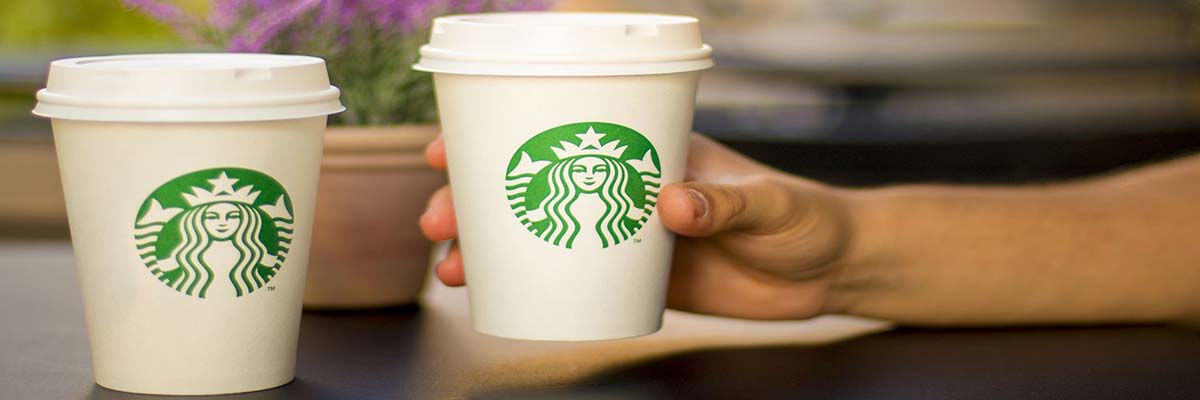How Starbucks Could Have Saved The World?
Starbucks talks the talk but can they walk the walk? “Beginning to use post-consumer recycled-content hot-beverage cups is an important milestone for Starbucks in addressing the environmental impact associated with our paper-buying practices,” said Jim Donald, Starbucks chief executive officer.
Yesterday I listened to a four-minute radio story about the new Starbucks coffee cup. Apparently as the company became successful in the 1990’s, more and more customers developed a wasteful habit known as double cupping. Customers started using a second paper cup to keep the hot liquid in the first paper cup from burning their hands. It sounds like a simple solution to the problem of carrying around a scalding hot beverage. The practice however instantly doubled the amount of waste created by drinking Starbucks coffee not to mention the additional trees and energy necessary to make all those second cups. The company began looking for an environmentally sensitive solution back in 1996. It came up with a sleeve made from 60% post consumer recycled paper. However, the hunt for the prefect coffee cup continued.
Recently Starbucks announced a break through. It now offers a cup made with 10% post consumer recycled paper. That’s not a very high percentage, but it is a landmark. Until this Starbucks cup, the FDA had never approved recycled paper for use on the inside of hot beverage cups. Initially challenged by the National Resource Defense Council, Starbucks was also aided by Metafore, a “non-profit group that collaborates with leaders in business and society to create innovative, market-based approaches that support thriving forests and communities.” In addition, the coffee icon worked with the Alliance for Environmental Innovation, a joint initiative of Environmental Defense and The Pew Charitable Trust. Wow. That’s sounds like quite an undertaking. If you have been emotionally moved by the enormous exertion Starbucks has gone through to produce an “environmentally friendly” coffee cup, you might want to stop reading now. This is where I get a bit cynical.
Remind me again, what was the original problem? Oh yes, Starbucks’ customers were wasting too many paper cups. Wouldn’t it be simpler just to reuse non-disposable cups? Call me crazy, but if customers reuse a coffee cup for years, wouldn’t that be an easier way to reduce the number of chopped up trees, the amount of landfill waste created and the energy used to make all those paper cups?
To be fair, Starbucks does have a program where by customers willing to use their own mugs are given a $0.10 discount. Customers drinking coffee in Starbucks stores have the option of using ceramic mugs instead of paper cups. My question to Starbucks is why did it take me 15 minutes of searching on the internet to discover this information? I have visited Starbucks on many occasions in multiple locations throughout America. I have never seen these options prominently displayed. And a 10 cent discount? Come on- the paper cups cost more than that.
Starbucks seems to have spent a great deal of effort to create this new recycled cup. What would have been the result of using such an effort to really change the way people behave? I can answer that. The result would have been a huge shift in the way we behave. The result would have been Americans waking up to a wasteful behavior and changing to do something about it. Certainly if Starbucks had chosen this idea there would have been hurdles to clear. Any change requires solving problems but couldn’t Starbucks have spent its time and money on those problems instead of dreaming up a new cup? Starbucks could have been the hero that made it happen. Starbucks however, chose not to engage its customers but to spend thousands of dollars and thousands of man-hours on a solution that enables consumers to continue a wasteful behavior. How hard is it to take a coffee cup with you on the way to work? How hard is it to bring it home and wash it in the evening? The answer: extremely hard.
Not the answer you were looking for was it? In truth, the physical act of carrying a coffee cup to work and bringing it home to clean isn’t hard at all. The colossal challenge facing Starbucks, had they chosen to undertake the idea, would have been to change human behavior. I don’t know the individuals at Starbucks responsible for developing the new, recycled, disposable coffee cup. I assume they are good people who believe in reusing paper to reduce the amount of trees and energy wasted by virgin paper use; that or the folks in the boardroom thought it would look good as a marketing campaign. Starbucks realized however, that spending time and money to develop a new coffee cup and getting the FDA to approve it was probably easier than getting you and me to carry a reusable cup to work. And they were right. Humans are reluctant to change. Most of us don’t do it until it is absolutely necessary.
Take plastic grocery bags for instance. Most Americans don’t think twice about using hundreds, even thousands of plastic bags to carry home groceries each year. Just yesterday at the supermarket, I watched as the bag boy loaded a single jug of orange juice into its own plastic bag. I told him I didn’t need the bag, that the jug already has its own handle. He looked at me like I was from Mars. “But everything goes in a bag”, I could hear him saying in his own mind. All of us have been conditioned to think that groceries go into bags and at best these bags get recycled on the next trip to the store. More often they get tossed in the trash and hauled off to the landfill. Most Americans haven’t considered an alternative beyond “paper or plastic.” Not me though. I asked for and received two canvas bags for Christmas in 2005 so I could carry my groceries home in a more sustainable way and still I have failed! How could my plan not have succeed you ask? On many occasions I simply forget to take them with me. I can fault others for not being willing to change, but I cannot fault them for being human. It takes mindful effort and a bit of time to change—that or some sort of carrot and stick approach to modifying our behavior.
The latter is where Starbucks has failed and grocery stores in the Netherlands have succeeded. On a recent visit to that country, I was astonished to find plastic grocery bags cost the equivalent of more than $0.50 each. I spent almost $5.00 on my first visit! I noticed on my way out that many of the Dutch citizens standing in line were carrying previously purchased bags. I should explain that the bags in Dutch grocery stores are of a higher quality that the flimsy ones sold here in the United States. But, they’re still plastic- the equivalent of the bag you’re offered at a shoe store. And the people of the Netherlands were reusing them. The price was set low enough that it was not a tragedy if you found yourself without a bag to reuse and had to buy one. The price was set high enough however to remind you to take a bag with you to the store—a gentle reminder that plastic bags are of value and should be treated as such.
What if Starbucks had taken this approach? What if they had decided to offer reusable coffee cups at or near the cost of cup production and what if they had coupled that offer with a substantial reduction in price for those willing to bring the coffee cup back with them again? Could the time and money spent on developing a new cup and producing those cups have been better spent gently reminding Americans that using less is best?
It is hard to change our behavior. It is hard for companies to help effect that change. They run the risk of negative attention from competitors, alienating their customers, or just being labeled as cheap. If we’re going to live more responsibly as individuals and as a society we are going to have to be more conscientious about how we live our lives. We are going to have to embrace changes that fly in the face of conventional consumer culture. And we’re going to have to nudge along those who sell us our products. We are, after all, the consumers. We’re the ones who keep using the cups. Here’s my challenge to Americans: stop accepting wasteful practices and begin demanding that those who would sell us stuff use their talent and American ingenuity to do so in a more responsible way. Apparently they can’t hear us in the Starbucks boardroom yet.







